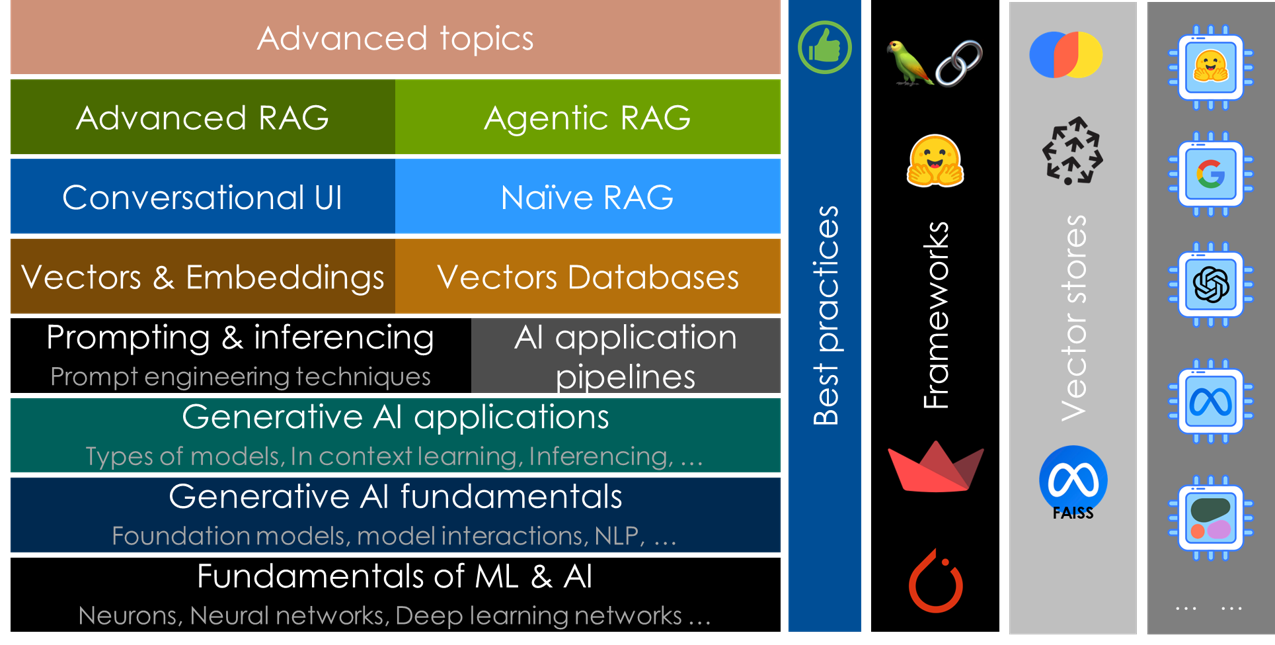About this guide
This is a companion guide for the course Generative AI application design & development by Raj@ACloudFan.com
I structured this course based on my own experience learning Generative AI technology. Having faced the challenges firsthand, I designed this course to simplify the learning process. It’s tailored specifically for those without an AI/ML background, helping you quickly get up to speed with generative AI. Raj
Generative AI application design & development
This comprehensive course on Generative AI Application Development offers a deep dive into the fundamentals and advanced applications of Generative AI technologies, focusing on the use of cutting-edge models and tools. The course begins by introducing core concepts in artificial intelligence, machine learning, and neural networks, with practical exercises on setting up neural networks and working with platforms like Hugging Face.
Who should take this course?
Anyone interested in learning how to build smart applications using Generative AI technology.
Solution/Application Architects:
Professionals looking to design cutting-edge applications that leverage LLMs to create more interactive, efficient, and intelligent solutions.
Application Developers:
Developers interested in acquiring hands-on experience with tools, techniques, and frameworks to build AI-driven applications that can understand, generate, and respond intelligently to user inputs.
IT Professionals:
Individuals aiming to transition into the growing field of Generative AI by gaining foundational knowledge and practical skills in AI-powered application development.
Data Scientists:
Data professionals who want to expand their expertise by learning how to apply generative AI models to create sophisticated applications, beyond traditional data analysis and machine learning.
What will I be able to do after taking this course?
-
Gain a solid understanding of Generative AI and Large Language Models (LLMs)
Learners will master the core concepts and principles behind Generative AI, how LLMs work, and how they can be applied in real-world use cases. -
Design and build intelligent applications using both open-source and proprietary LLMs
Develop practical skills to design, architect, and implement smart applications leveraging a wide range of LLMs from both open and closed sources. -
Utilize leading tools and frameworks, including LangChain, HuggingFace, StreamLit, Ollama, and more
Learn how to effectively use popular tools, frameworks, and libraries to streamline the development of AI-powered applications. -
Apply best practices for integrating generative AI models into applications
Understand and implement best practices when it comes to efficiency, scalability, and responsible use of generative AI in production environments. -
Identify and navigate challenges specific to generative AI
Explore and troubleshoot common challenges such as data bias, model interpretability, performance issues, and ethical considerations related to AI use. -
Prepare for intermediate-level technical interviews for roles in Generative AI
Feel confident in your ability to handle interview questions related to generative AI concepts, application design, and development, preparing you for technical roles at an intermediate level.
What are prequisites for this course?
The first and foremost : You need to be hands-on as you will be installing and using tools to gain hands-on experience in building Generative AI applications.
Basic knowledge of Python programming:
You should be comfortable writing Python code, as this course involves coding and interacting with AI models via Python-based frameworks.
Familiarity with Jupyter Notebooks:
Experience using Jupyter Notebooks will be helpful, as much of the hands-on work will be done in this environment to interact with models and run code.
A personal machine (Windows, Linux, or Mac):
To run AI models and the associated tools, we recommend a machine with a minimum of 16 GB RAM. This ensures a smoother experience when handling AI workloads.
A stable internet connection: You’ll need decent internet to download tools, models, and datasets, and to access resources for the course.
Here is a visual representation of how the course is organized:

FAQ
When is this course releasing?
The estimated publish date is September 23rd, 2024.
I am interested in getting access to the preview?
Send an email to raj@acloudfan.com
Interested in joining this course?
If you are interested in joining this course, please add your email to the ineterest and I will notify you via email.
Regards, Raj